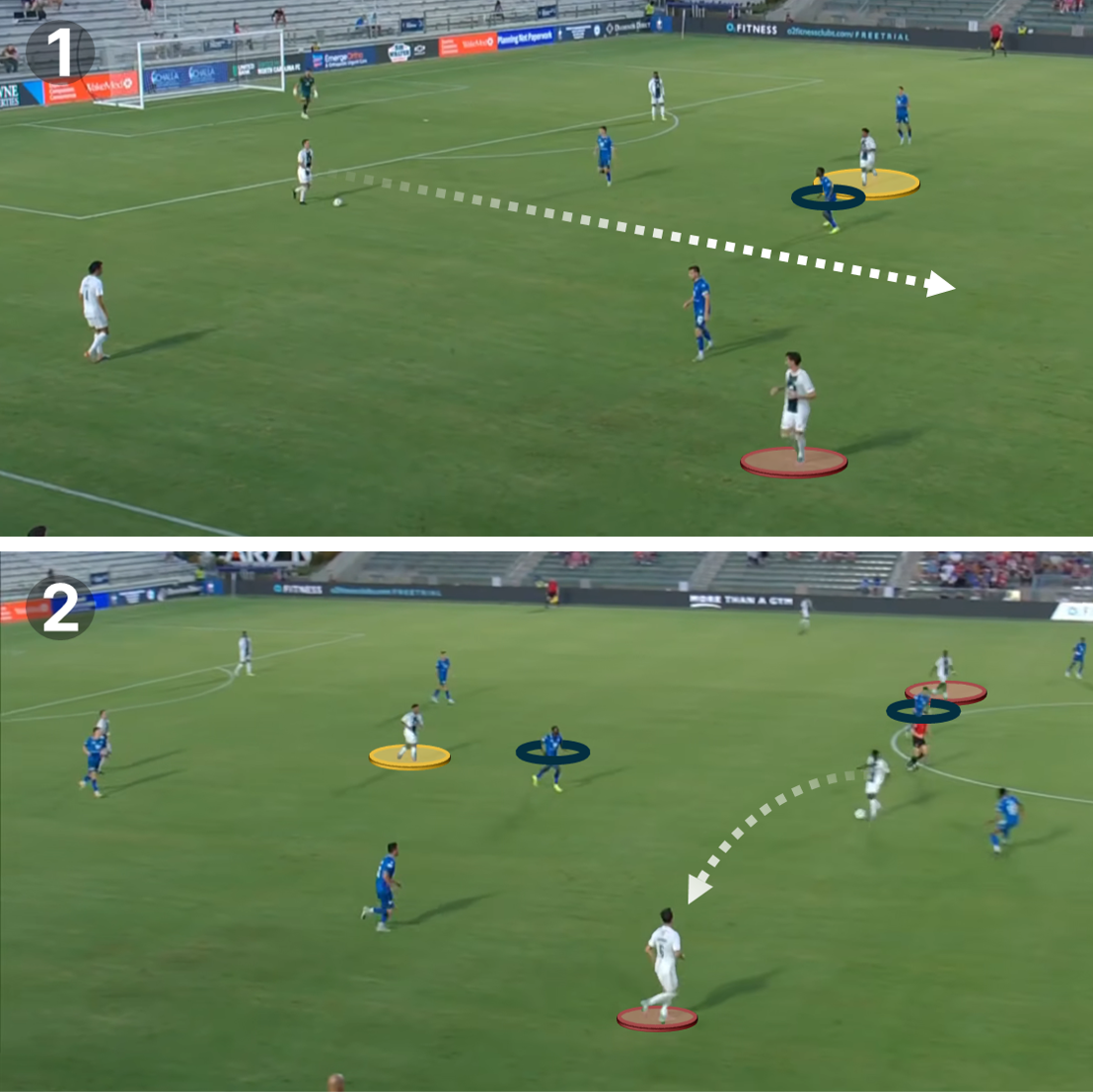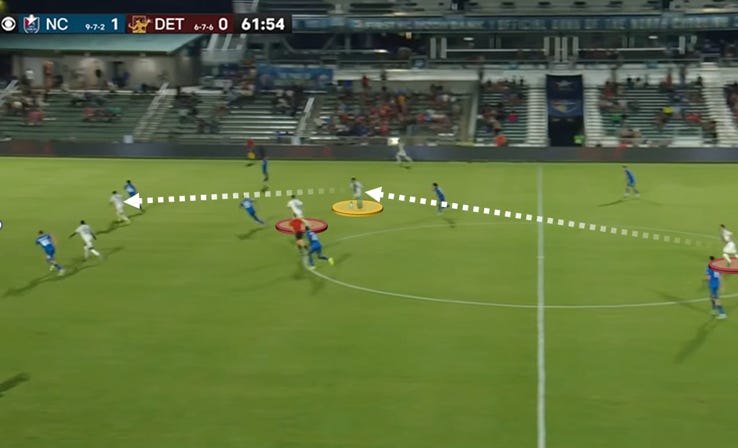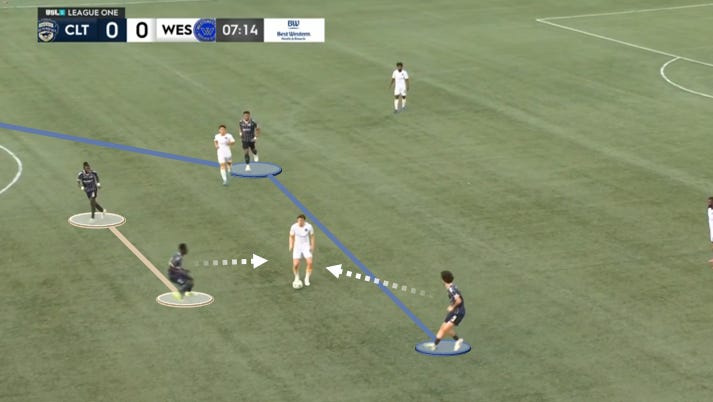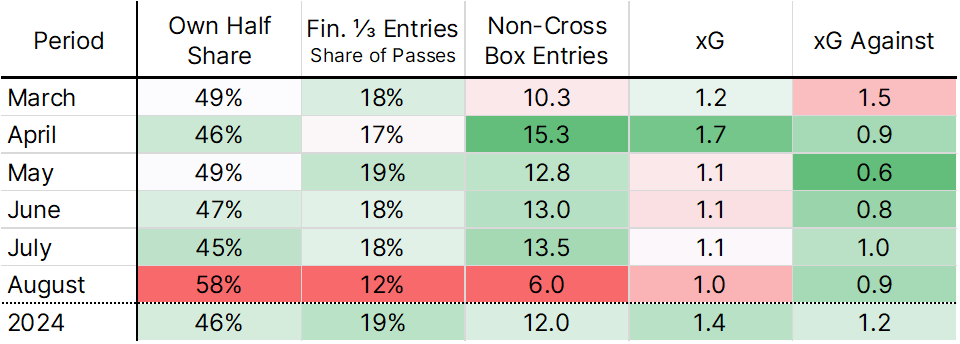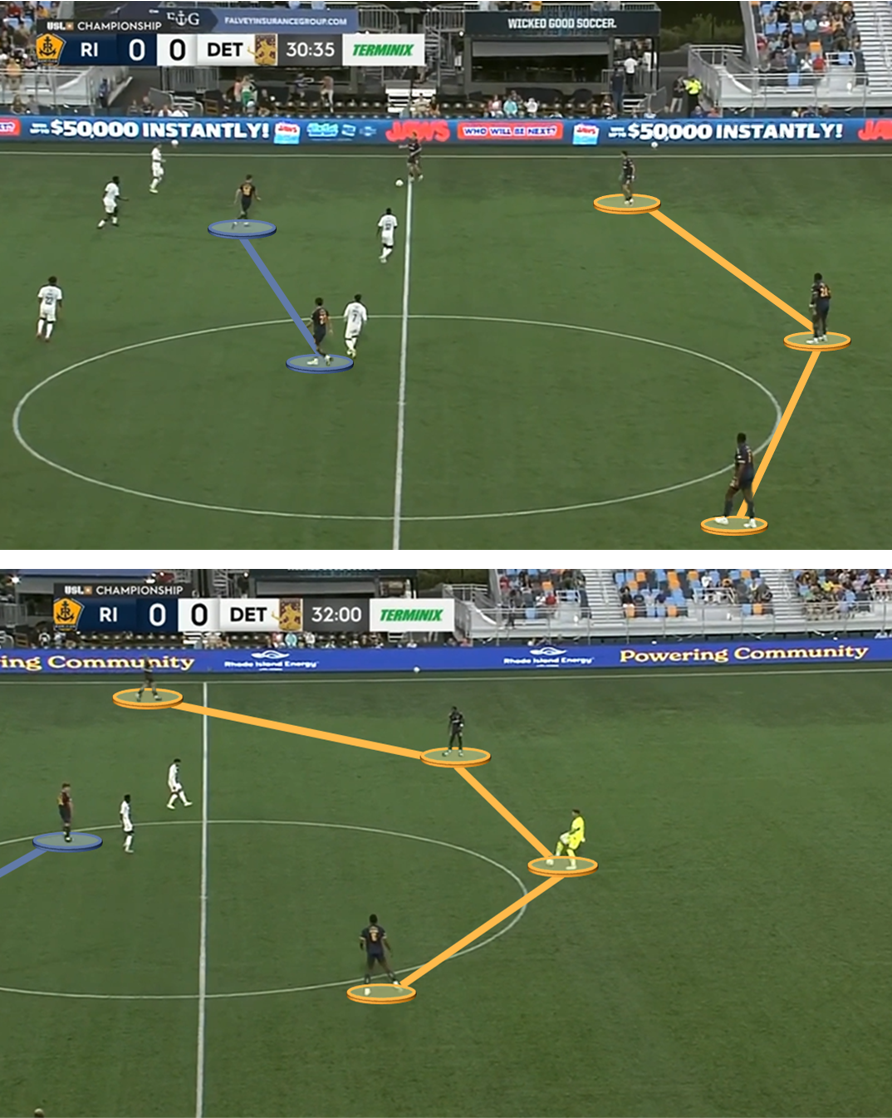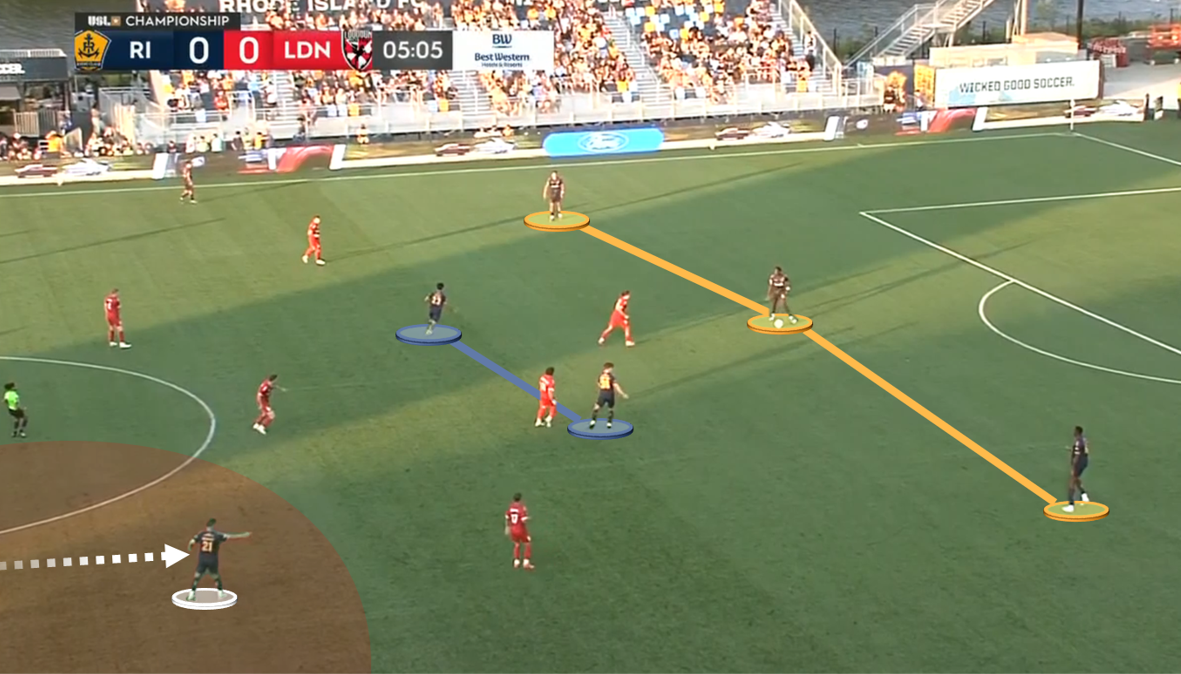The Back Four: Evans, Rizzo, et al.
On positions changes, Rhode Island's system, Charlotte, and more from the USL Championship and USL League One
Welcome in to The Back Four!
Before we start, check out Backheeled for even more Josh Jones love, ample transfer talk, and more. You can also find This League! on the site for an audiovisual dive into the week that was.
Without further ado, let’s get to it.
North Carolina, Detroit City, and the willingness to adjust
The sequence below is exactly what Danny Dichio hoped Detroit would look like on Friday night, facilitated by a right-tilted back line and clever midfield spacing. As we’ll see, North Carolina’s chameleonic defense often stopped that blueprint, but that’s for later.
In the meantime, note how Detroit aligns their defensive unit. Two center backs stay tight, Shane Wiedt (their right-sided center back) elbows up. Often, Le Rouge dropped a center mid deep to approximate a back four, and Kobe Hernandez-Foster (denoted in gold) does the job here…
…in a bid to encourage North Carolina to overextend.
Here, the gambit works. As Hernandez-Foster drops, Jay Chapman and Laye Diop stay higher. NCFC’s pivot has to split, giving forward Ates Diouf the room to drop in and lay off toward Jay Chapman in space
For large spells of the Week 24 bout, DCFC looked like the better team because of those patterns. I say better in the sense of “passing coherently,” but it was far from a cakewalk. Instead, some of this club’s recurring issues came to bear, in large part due to a well-tempered defensive response from North Carolina.
To set the table, Detroit is statistically weird. They’re really slick in build (at least when they aren’t turning the ball over!) but tend to hit a wall closer to goal. Le Rouge sits in the bottom third of the Championship by turning just 36% of their final-third receptions into box entries. Moreover, they’re reliant on crosses; 63% of their passes into the 18-yard zone are crossed, a top-third rate.
North Carolina knew those facts going in, and they adapted their defensive approach to accentuate the final-third difficulties. John Bradford generally likes to mix up his pressing stance, and on Friday he quickly pivoted toward a 5-1-3-1 (or thereabouts) to keep an eye on Hernandez-Foster in deep positions while still retaining a holding No. 6.
By flexing the midfield as such, Bradford invited some level of danger. We saw that above, where Detroit broke lines into a halfspace pocket.
The response? Allowing the back three to step up and plug those holes. NCFC’s best two chances of the game came from those exact situations, bred of turnover-driven breaks. The first is seen above, with Bryce Washington clogging up the midfield and allowing for a break into Pedro Dolabella. Later, Dolabella would be the set-up man, furnishing Evan Conway with a 58th minute breakaway after both Washington and Finn Sundstrom stepped in tandem to create a turnover.
NCFC deserve their plaudits for getting aggressive. This match featured four interceptions from their center back trio, the second-highest total we’ve seen in any league game this year. Moreover, the back three only had to contest 10 duels because of the efficacy of that 5-1-3-1 in clogging space.
Some of the “center back takeaway leading to a break” phenomenon owed to Detroit’s setup. Wiedt’s far-right position was answered by a narrow Devon Amoo-Mensah on the left, and that opened the channel. If Amoo-Mensah didn’t get support from Alex Villanueva or a recovering No. 6, then there was ample space in which to attack.
Out of halftime, Detroit wisely re-oriented their shape to (1) minimize those defensive frailties and (2) maximize Hernandez-Foster. The change was simple: play in a more normal 5-1-2-2, but use Hernandez-Foster as a No. 8 with Ryan Williams subbing in as the lone holder.
With the roles delineated, Detroit’s offense began to make more sense. You’re seeing a prime example screenshotted above, with Hernandez-Foster receiving between lines; he’s about to hit a terrific pass into Darren Smith to level the match.
Williams only took a modest 34 touches, but he turned nine of them into final-third entries, and on 89% accuracy, no less. Chapman, by contrast, completed just 54% of his similar attempts. Meanwhile, four-fifths of Hernandez-Foster’s passes in the second half originated in the attacking zone, as compared to just 46% in the opening 45 minutes.
The ex-Birmingham man’s speed of thought didn’t let NCFC activate their center backs nearly as often. Williams played a part as well, squeezing passes between lines without a second thought.
Friday’s draw was, ultimately, a fascinating example of how these two clubs – both firmly ensconced in the race for a home playoff match – experience their highs and lows. Even when North Carolina is dialing up their defensive pressure, they’re playing a fundamentally familiar shape and staying within a certain distance of their basic setup. Detroit, by contrast, takes swings. That manifests in terms of in-game strategy, but it’s also why Hernandez-Foster is a member of Le Rouge in the first place.
We’ll see who ends up better off in the East come playoff time, but the differing approaches made for one of the week’s most interesting games.
Charlotte’s shutdown press
Entering Week 24, Charlotte ranked third in League One for midfield recoveries but dead last in interceptions. This club is devilishly good at forcing you to make mistakes, but they’re not going to overextend to make it happen. Mike Jeffries’ side is hyper-aware within their 5-2-3 pressing structure, relying on steady pivot play and assured weak-side rotations to stay solid. All of that was on show this Friday against Westchester.
This was a padawan-versus-master battle between Dave Carton and the club at which he spent nearly two decades. We’ve seen WSC revert to their first-choice back four as of late, and the 4-2-3-1 they used in Charlotte was designed to break the aforementioned system with vertical, varied progression.
The rub? Charlotte seldom allowed the opposing pivot to engage. The Independence’s press, in a very literal sense, boxes you in with a four-vertex approach up front. In the example here, Omar Ciss and Bachir Ndiaye form the baseline in the pivot, while Jon Bakero and Christian Chaney are active in the front line. You don’t even see Tumi Moshobane on the weak side, which is a feature rather than a bug.
What can Westchester’s Daniel Bouman do as he receives here? Well, uh, not much! There’s a slim window to pass to his left side, but it’ll close in an instant thanks to Bakero’s recovery. Instead, WSC will have to look backwards and reset.
This is Charlotte at their shapeliest, and it’s a marker of their style of play.
That’s not to see that Carton and co. didn’t get their licks in. Take the situation above once more. Often, you’d see Bouman or fellow pivot mate Taimu Okiyoshi turn against the ball-side winger, use their back as a shield, and swing a switch pass to a fullback on the far sideline. The same thing could happen with an extra step if WSC’s center backs were quick-thinking enough after receiving on the backpass.
At that point, Westchester could rely on fullback-winger combinations to work through. The trick was to earn those advantages apace, using tempo to catch Charlotte out. Failing to do so resulted in yet more trapping – and the Independence’s opening goal.
Here, Westchester gives-and-goes through Okiyoshi, hoping to utilize a drop from one of their wingers to quickly work through. Instead, the ball-side drop from Moshobane slows the potential break, and the reaction from the midfield is timely.
Consider what’s happening on the weak side, where Bakero is low. Because the Spaniard takes up a low position like a proxy center mid, Ciss and Ndiaye are allowed to slide to their left and close down. Here, it means that Ciss can force a turnover. Within seconds, Charlotte use that recovery and turn it into a finish.
Between that excellent pressing and a very considerate performance from Nick Spielman against his former teammate JC Obregon, the Independence did splendidly to keep play in front of them. WSC found ways to play over the press – see a 60th minute diagonal from another ex-Charlotte man, Joel Johnson, to Obregon – but generally struggled to access zone 14 or find any soft underbelly of note.
With the win, Charlotte is now 10 points above the playoff cut line. My modeling gives them a 95% chance of making the postseason, and even that feels low. So much of that success owes to the defense. Even after last weekend’s wild 5-4 shoutout against Greenville, you’d still trust this Independence team against almost any other unit in League One when it comes to their structure, chemistry, and quality.
Connor Evans!
Connor Evans is good. Really good. Not only has the 23-year-old rookie created a league-high 27 chances from set pieces for the Greenville Triumph, but he’s also ninth in League One with 19 chance creations in open play and third-ranked with five assists. All of that success has come while Evans has shifted from the right flank into the central midfield.
Evans went into the lineup instantly at the start of 2025, splitting time between right back and right winger roles in the spring. The Portland-by-way-of-Stanford product ultimately picked up 1150 minutes in those positions until the mid-June reorientation.
The Triumph are League One’s most aggressive pressing team, and Evans meaningfully contributed to that setup from the wide areas. Greenville mostly based their system out of a 4-2-3-1 or thereabouts, and Evans understood how to close down to make opposing receivers uncomfortable and, often, take the ball away.
In the meantime, the rookie hit 3.8 open play crosses per game across all competitions on a 25% accuracy. Only Dion Acoff and Gabriel Alves put up a higher completion rate on a comparable volume. Greenville couldn’t always nail down the rest of their attacking line in those early months, but Evans stepped up to the plate as a provider.
Naturally, those crossing numbers have gone down as Evans’ role has changed. Splitting time between the No. 8 spot in a 4-1-4-1 and a No. 6 deployment in a double pivot, Evans has actually seen his recoveries and interceptions go down while vastly improving upon his progressive passing.
Start with those defensive marks. The typical center mid hangs his hat on ball recoveries and takeaways, but Evans has been asked to do something a little different. Often, he’s maximizing his pressing shadow or sitting deeper to clog space; think of Evans like the backstop behind a more muscular high press.
That role can take on different forms. In Greenville’s 2-0 win over Miami in the Jagermeister Cup, Evans did splendidly to shadow attackers like Allen Gavilanes and Sebastian Blanco, preventing them from receiving between the lines. Against Chattanooga, a similarly deep position allowed the rookie to contest second balls against a highly direct foe. It’s no coincidence that Evans contested 13 duels in that match, leading the Triumph to a 3-1 win. As we’ll see, his aggression is what stood out against AV Alta this Saturday.
For my money, it’s Evans’ ability to use his right foot that makes him so terrific in the central areas. We know that the Triumph star is a terrific crosser, but he also excels at switching the point and advancing play upfield – often with a pass-and-move progressivity coming after the release of the ball.
Take the example above. Opposing Charlotte presses with one striker and two No. 10ish wingers, and Evans lurks behind that highest presser while waiting for his moment to arise. Once the striker commits upfield, Evans steps ahead to open himself for a bounce pass by way of his pivot partner, Chapa Herrera.
Upon receiving, Evans takes a controlling touch and waits a beat to push upfield. In doing so, he freezes Charlotte’s left mid, opening more space in behind for his teammates to create a two-on-one against the opposing wingback. While Evans’ entry pass into the final third doesn’t connect, the patience pays off; Greenville has numbers to push the issue, counterpress, and regain.
This weekend, Greenville went toe-to-toe against another smooth possession side in the form of AV Alta, and Evans faced a different sort of challenge. Within the 4-2-3-1, there were a few early moments where Evans allowed swooping runners to cut across his face. The slow reactions let Alta break lines, particularly when Herrera had already stepped forward as a marker; the byproduct was an ability to isolate and target Tyler Polak on the weak side.
If the start was slow, the second half was evidential of why this is such an effective player. Evans helped to lead a much-improved pressing effort that ultimately preserved a point for Greenville.
Within the Triumph’s 4-1-4-1ish second-half look, Evans was particularly good about pestering Jimmie Villalobos on the opposite side. At times, you’d see #18 push all the way to the edge of the box to track his mark.
Here, the Triumph press with Chevone Marsh rather low on the right side and Pascal Corvino covering space from the No. 10 spot. As Alta tries to penetrate, Evans is marking Villalobos, and he’s there to out-muscle his opponent after Marsh pairs with Herrera to crunch the entry pass.
As Greenville move forward and find Rodrigo Robles at his feet, Evans probes forward and curls into the channel. In a perfect world, Robles would first-time a pass his way. Instead, the Triumph are a bit more considerate. Evans recognizes that the immediate opportunity is gone, but he keeps moving and sets himself up on the edge of the box to possibly receive on the cutback or field a botched clearance.
This was par for the course in a second half where Greenville’s upfield pressure set the tone. Between the shape shifts in the attacking zone and excellent performances at fullback from Toby Sims and Tyler Polak, you could see the game change before your very eyes. Amidst that altered momentum, #18 managed to carve out two shot attempts, four recoveries, and a whopping 10 entry passes into the final third.
Greenville is League One’s most chameleonic team when it comes to their week-in and week-out shape, but they can always rely on Connor Evans to buttress the system no matter its specific look. On the wing and in the midfield, Evans has been nothing less than a star in 2025. He proved it again in California this weekend, and it might just put him on the trajectory for a Championship move this winter.
R- to the -izzo
If you’ve kept up with my Phoenix coverage this year, you’ll already be sick of me complaining about lax wide defending and generally stagnant midfield play. Not to be repetitive, but those are still big issues!
The emergence of better options at the fullback spots has made those issues feel a little bit smaller. Namely, it’s the emergence of Pierce Rizzo that’s changing the game.
Before we dig into the academy product, it’s useful to contextualize the problem. Against Lexington a week ago, Rising opted for a 4-2-2-2 with Charlie Dennis and Emil Cuello as their wingers. In the preceding double matchweek, Darius Johnson, Dennis, and the now-sold Jearl Margaritha all took their turns. These are very much unsettled positions in a team that isn’t committing to a midfield shape.
The high-level numbers can be a bit misleading, but they paint the picture of a passive wing corps. Yes, Darius Johnson and Ihsan Sacko have played a good share of their minutes at the No. 9 spot. Yes, Dennis gets a slight boost from his time spent as a No. 8. Level it all out, and you’ve still got a set of wide options that lose the vast majority of their duels, rarely recover the ball, and – according to the eye test – often fail to track back.
It’s not as if Phoenix has solved those issues in one fell swoop, but the 18-year-old Rizzo’s individual performances are making things feel far more stable.
Coming out of the Rising Academy, Rizzo was considered to be a center mid, and that’s where his first few professional appearances came. Then, two weeks back against Birmingham, the teenager moved to right back That match turned into a calamity for Rising, but Rizzo’s entry passing into Dennis up the right side was genuinely tremendous. The youngster has only continued to improve since then.
Against Tampa Bay on Saturday, Rizzo’s full impact was on show. Particularly in the second half, the academy starlet set the table for what should’ve been a Phoenix win.
Here, you’re seeing all sides of Rizzo’s game. From the jump, he’s setting the table under pressure, linking with teammates in the midfield by swiveling and juking with an advanced sense of tight control. When Rising are unable to pass their way through the Rowdies’ defense after Rizzo’s entry pass, the right back is there to put a body on an opposing attacker and keep Phoenix’s field tilt going.
If this club isn’t going to get full-throated tracking from their wingers, these sorts of fullback interventions are paramount. Before Tampa Bay can even think about causing a problem in the attacking half, Rizzo is stepping up to the plate and making a stop. The 18-year-old went six-for-seven on duels this week and added two tackles for good measure – and that came alongside the steady passing into Johnson and Sacko.
Even when he didn’t receive, Rizzo understood how he could pin Tampa Bay within the structure of Rising’s 4-2-3-1ish shape. In this case, Phoenix gets a terrific dribble from Damian Rivera on the left side, allowing them to penetrate into zone 14.
While Rivera will ultimately loose a shot from that area, it’s worth noting what’s on the table in an alternate universe where he decides to pass. That’s where Rizzo comes in.
As the dribble takes place, the right back pushes into the halfspace, pairing with Johnson to create an effective two-on-one against Tampa Bay’s left wingback. If Rivera were to release a pass on his right foot, he’d find Rizzo and Johnson with an advantage that owes solely to the fullback’s spatial understanding. Likewise, if this play ended in a botched clearance, Rizzo would stand ready to recover the ball and keep the offensive move alive.
Is Pierce Rizzo the full solution to Phoenix’s problems? Not entirely, but he’s elevating this squad in a meaningful way. The teenager will end up at UC Irvine at some point, but he’s laying down the blueprint for how Rising can circumvent their wide dilemma and control matches in the home stretch of the season.
Rhode Island’s road ahead
Rhode Island got back into the playoff field after Week 23, and we might look back on that double matchweek as a turning point in 2025. Not only did RIFC get over the line, but they added Matthew Corcoran and Dwayne Atkinson while meaningfully shifting their style.
The cause for that evolution? Corcoran’s presence as a premier tempo-setter played a part, but Koke Vegas’ reintroduction might’ve been even more vital. When the Spaniard has been in the lineup this year, RIFC has scored a very bad 1.0 goals per game – but that’s twice their mark (0.5) with Jackson Lee in the team. Vegas starts also see Rhode Island hold 55% of possession and complete 7% more passes into the final.
Lee is a very good shot-stopper, but Koke Vegas is a build-up unicorn. He’s a steady all-range passer with a one-of-one ability to act like an extra outfield player. Pair him with a metronome like Corcoran, and you’ve got a team that’s far better at slowing matches down and controlling territory with possession.
Admittedly, the early numbers of the Vegas-Corcoran era are mixed. Rhode Island has struggled to break into the opposing half and has taken far fewer passing risks. They haven’t been able to work into the box with control, though their xG returns have stayed relatively flat in a season-wide context.
Still, think about that control aspect. When you’ve got the ball at your feet and are forcing opponents to give chase, you’re tiring them out and keeping pressure away from your own net. With players like Vegas and Corcoran driving the train, you’re also likely to be gradually pushing upfield, tilting the pitch a little bit more with each bounce pass.
The rub? The short passing hasn’t come with extra possession. Against Detroit and Loudoun, RIFC held a cumulative 46% of the ball. Still, that feels exceptional considering the opponents at hand and red-card fueled weirdness against Le Rouge.
In any case, Rhode Island’s defense has remained elite all year, and the short passing style isn’t going to change that fact. It’s worth experimenting to fix the offense, especially for a team that clearly hasn’t magically returned to their 2024 heights with JJ Williams fit.
I praise the concepts at length to circle around to a second point: there’s plenty of room for improvement. Rhode Island was probably too negative and cautious last week, and Corcoran was the key example.
Through two games, the Nashville loanee’s average pass has traveled -2.0 yards upfield. That’s nerd-speak for “backwards,” and it’s extremely so. Corcoran’s mark is dead-last among USL mids, more than twice as regressive as the next-closest player. The average midfielder’s pass moves 3.7 yards upfield!
Moreover, that lack of turn-and-progress spark up the middle means that opposing presses don’t have to respect all the ball circulation. You’re seeing as much above in examples from the Detroit game.
Ideally, Rhode Island’s 3-4-3 build shape will goad the opposing midfield forward, opening space to advance between the lines. That can happen in a few ways. Marc Ybarra might receive in the pivot, turn, and dribble past an opponent. Ybarra or Corcoran could receive – perhaps from an advanced Vegas in a pseudo-back four –draw pressure, and then lay the ball off to a wide teammate. RIFC could skip the pivot entirely, using their center mids as stalking horses for a center back-to-forward ball.
Those scenarios have been too rare in practice. Even as Rhode Island has successfully implemented a more dogmatic structure, they’ve lacked a sense of tempo and a proper risk-reward balance at important moments. Above, that means that Detroit’s press is forced to neither bend nor overextend.
A few more shape notes to consider. For one, RIFC has tended to use one of their wingers in a deep possessive position. Even before the short-passing shift, you saw Albert Dikwa stay high and Noah Fuson go low at the start of August against Pittsburgh. Since then, Jojea Kwizera (17/31 touches in the defensive half against Detroit) and Maxi Rodriguez (24/47 versus Loudoun) have each taken a turn.
You’re seeing Rodriguez drop in here, providing a useful outlet between lines. Loudoun’s 4-2-4 press was far likelier than Detroit’s to take the bait and close high, meaning that #21 was accessible in the channel to either side of the opposing pivot.
The problem? Loudoun also allowed their back line to push high, meaning that a fullback or center back would close to Rodriguez as soon as he received. Access to the opposing half still went wanting in those situations, owing to lacking third-man movement from Corcoran and Ybarra between the lines.
Rodriguez attempted just four passes into the final third and two total long balls, running contrary to the profile that made him so special in seasons past. Again, the structure was good, but the lack of individual expression tended to hurt.
The Loudoun game was still an overall step up, particularly in the final half-hour. Two changes sparked that vivacity: Dwayne Atkinson’s debut as a left-sided attacker and Zach Herivaux’s entrance as the right-sided center back.
The substitutions helped in a few ways. Atkinson was incredibly bright, operating next to JJ Williams and in front of Rodriguez in more of a 5-2-1-2 concept. His ability to receive in tight spaces and turn on the jets as a dribbler made RIFC fundamentally more dynamic.
Herivaux, meanwhile, is spotlighted above. A longtime Khano Smith acolyte, Herivaux has played as a No. 10 at times for this club but has the skillset to play far deeper. In this case, he’s taking that Bacharach-esque elbow position on the right side of the back three to a new level, trading spots with Corcoran to addle the Loudoun press.
The opposing 4-2-4 narrows in response, allowing Corcoran to play a refreshingly progressive pass toward the sideline. Meanwhile, Herivaux makes a needed third-man run up the channel, receiving and guiding his side into the attacking zone. It’s not too far from the ideal of positionless soccer, yet you’re still seeing the structures and principles that RIFC want to hang their hat on.
So where does that leave us? It seems as if Rhode Island will run with this style for at least a few more games, and they’ve learned a lot about how to make it work.
Time will tell whether Atkinson and Herivaux get deserved starts. For now, RIFC’s lessons are clear. The short-build 3-4-3 has clear upsides, but it can only work with a proper sense of tempo and brave off-ball movement.
Quick Hits
In other news this week…
My friends over at The Union Report have some must-read discussion of USL salary structures.
Likewise, Luke Martin has a terrific primer on Mark McKeever as he takes over South Georgia Tormenta. I’m biased because I’m quoted, but it’s a great read – and a crucial one with Tormenta back in the win column.
I‘m all plugs today, but do check out Nicholas Murray’s latest on the Tampa Bay Rowdies’ 50th anniversary celebrations from the weekend. Soccer history runs deep here, folks.
Amidst the Danny Trejo news and other midfield delights, I failed to mention in Backheeled that Peter Wilson has arrived. Against Sacramento, Wilson only took one shot but ate up space like a menace. His 20 touches outside of the box tended to come in line-breaking situations that bent the Republic’s back three. In the 18-yard box, he’s learning how to move and buy space for this luminous Roots midfield.
At the moment, Wilson is eighth in the league in xG (7.3) and basically at par in terms of xG on target (7.0), the sign of decent finishing. His 33% duel win rate is low and caps Oakland’s tactical versatility, but this team has enough technique and – thanks to Trejo – guile that they probably don’t need that long-ball alternative. I hope he keeps scoring, because this team is so fun.
Lest you thought I’d end on soccer, I’ve got movie takes. Studious readers will remember me singing the praises of Akira Kurosawa’s High and Low a few weeks back, and it’s with the utmost delight that I report Spike Lee’s new Highest 2 Lowest to be my favorite movie of the year so far.
Kurosawa’s original is a highly formal examination of post-war class antagonism in Japan. Stagey blocking gives way to handheld, documentary realism, and it’s the marriage of form and plot that’s so inspired – and, ya know, it’s a fun kidnapping thriller! By contrast, Lee is a maximalist at the core, and Highest 2 Lowest is absolutely bursting with over-the-top, stylized energy. This remake is interested in that idea of resentment, but it rejects the descent-into-hell filmic structure for spontaneity.
The attention economy – how social media brings class extremes closer in sheer proximity while still keeping them apart in terms of actual opportunity – is on Lee’s mind, particularly as it relates to the black community. Denzel Washington’s lead performance as a record executive facing comeuppance by a spurned rapper manifests those themes. He’s bringing absolute can’t-look-away charisma alongside the genuine doubt of a titan losing his touch, burdened by fatherhood and the desire to leave a creative legacy. The first hour of this movie is talky and choppily edited and plagued by an overbearing score – you barely notice because Denzel is bringing it. Lee’s love for staccato blitzes of dialogue have never been in better hands.
There’s a subway sequence midway through the movie that starts with blaring orchestra, swerves into diegetic street music, and elevates the movie for the rest of the runtime. It’s total bravura filmmaking. Everything after that point is undeniable, Lee in his absolute sweet spot. The great man (“highest”) is leveled (“lowest”) and has to find his own remuneration, unable to turn to an equitable or effective justice system as in the original High and Low.
I’m not here to argue that the ideas are particularly novel or that every element works, but it’s so refreshing to see a master working with this level of bravado. A$AP Rocky is the villain! You stop down for a three-minute music video in the middle of the climax! Rick Fox and Rosie Perez play themselves! Denzel and Rocky kinda have a poetry slam at gunpoint! Nothing else in 2025 has been as vivacious and enthralling and bursting with ideas.
(I was sitting next to an older woman, and she turned to me as the credits rolled and went, “wasn’t that amazing?” My thoughts exactly!)

